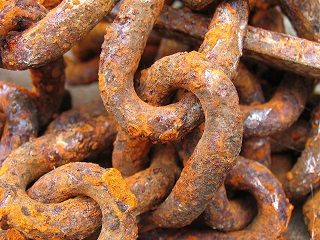From Guest Blogger Diane Smith: How to Remove Rust with Sustainable Processes

In most cases there’s no need to use any high-end rust removal products; a few simple items found in every home should do the trick just fine.
Potato
Cut a potato in half and cover the cut surface with salt. Scrub the rusty part firmly and add salt to the surface until it’s completely cleared. If this isn’t fast enough, you can substitute the salt with baking soda. Once you’re done, rinse everything thoroughly and wipe it dry. Oxalic acid will dissolve rust pretty easily and it’s found in potatoes and other plants (grapes for instance). Oxalic acid is perfectly harmless at low concentrations so this may be the best solution for rusted pans and dishes.
Vinegar
Vinegar is a great solution for items with easily accessible rusted areas. It requires you to soak the rusted metal in it, so it’s basically perfect for nails, screws and other small mechanical parts that corrode and take too much work to get cleaned. Place the screws in a bowl filled with white vinegar (apple cider vinegar is also an option) and after a day or so (the time varies depending on the amount of rust you want to remove), they should be nice and shiny due to the acetic acid found in vinegar.
Baking soda
Acid isn’t the only substance that can remove rust. An alkaline substance like baking soda can have the same effect. Mix the baking soda with water until you’ve made a nice thick paste. Apply the paste to the rusted metal and leave it like that for a few hours. Afterward, use the brush to remove the paste and rust beneath it and rinse the whole surface with water. For larger surfaces, especially those left outside and susceptible to the elements, preventing rust is even more important than removing it. This can be accomplished by using a rust converter, which also hides dents and scratches.
Lemon and salt
Rub the salt on the rusted area and don’t be afraid to use a lot of it. Then squeeze the lemon juice over it. Leave it for a couple of hours and scrub with a firm brush. If you’re worried about damaging the metal use the rind of the lemon instead. There really aren’t any rules because it all depends on the size of the surface and how much rust there is, but after a few hours, there should be a nice coat of paste on the areas you want to clean.
Electricity
If none of the above works, this method should be your last resort. Find a basin large enough for the items you want to clean. Add water and washing soda. Place a piece of metal you don’t need into the water. Connect the plus terminal of your car battery to the metal part you don’t need and the minus one to the rusted item you want to clean. Make sure the positive terminal is above the water. Plug the car battery in and leave it on for about an hour. That should do the trick.
Rust can be removed pretty easily with a just a couple of household items and appliances. However, making sure you protect the vulnerable items from getting rusty in the first place is always a preferable option.
